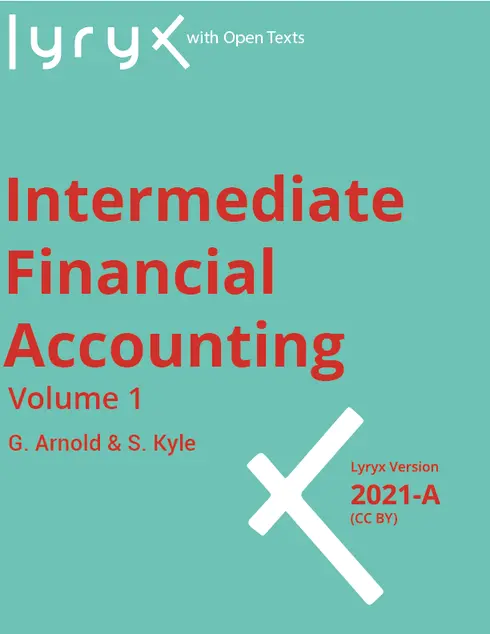
Intermediate Financial Accounting - 2021-A Volume 1
![]()
![]()
![]()
![]()
![]()
Glenn Arnold, Athabasca University
Suzanne Kyle
Copyright Year:
Publisher: Lyryx
Language: English
Formats Available
Conditions of Use
![]() Attribution
Attribution
CC BY
Reviews
Reviewed by Michelle Kleeberger, Accounting Instructor, Dakota County Technical College on 10/14/24
This OER text provides in-depth coverage of key accounting concepts used in Canada and the format follows a similar structure as others on the market. It also includes exercises, exams and solutions. read more
![]()
![]()
![]()
![]()
![]()
Reviewed by Michelle Kleeberger, Accounting Instructor, Dakota County Technical College on 10/14/24
Comprehensiveness
This OER text provides in-depth coverage of key accounting concepts used in Canada and the format follows a similar structure as others on the market. It also includes exercises, exams and solutions.
Content Accuracy
The information in the text appears to be accurate.
Relevance/Longevity
The book is structured so that it can easily be updated with accounting changes. This book has been updated 4 times since publishing.
Clarity
The text is clear, concise and uses proper accounting terminology.
Consistency
The format is easy to follow. Each chapter has learning objectives separated and subsections within each (when needed).
Modularity
It is easy to locate the start of each chapter which includes a real-world example of where the chapter is headed.
Organization/Structure/Flow
Text is well organized and the structure is similar to others on the market.
Interface
Interface is basic and easy to navigate.
Grammatical Errors
I did not find any grammatical errors.
Cultural Relevance
The text provides many real-world examples using a variety of companies experiences.
CommentsThis book is well done and contains information you would find in other accounting texts. It includes information from the Chartered Professional Accountants of Canada (CPA Canada), Accounting Standards Board (AcSB), Accounting Standards Oversight Council (AcSOC), International Financial Reporting Standard (IFRS), International Accounting Standards Board (IASB) and the Accounting Standards for Private Enterprises (ASPE). I would not use this book for my course offered in the United States as it is geared towards Canadian Accountants.
Reviewed by Lucy Lim, Associate Professor, Howard University on 12/14/20, updated 12/22/20
Topics covered are similar to the standard textbook. read more
![]()
![]()
![]()
![]()
![]()
Reviewed by Lucy Lim, Associate Professor, Howard University on 12/14/20, updated 12/22/20
Comprehensiveness
Topics covered are similar to the standard textbook.
Content Accuracy
No comment since I am not familiar with Canadian standard.
Relevance/Longevity
As with other accounting books, every time the standard changed then the book need to be updated. I cannot comment much since I am not familiar with the Canadian standard.
Clarity
Pretty clear so far when I read it, some are similar to US GAAP.
Consistency
So far I do not see any inconsistency.
Modularity
This book is much shorter compared to the usual intermediate book in the market. Considering the complex nature of intermediate accounting, it is great to have a short summary of it while keeping the important details in.
Organization/Structure/Flow
I would love to see more classification than just lesson for each topic. Highlight the important things.
Interface
Interface is OK but can be improved. Maybe include a search function? Each lesson is kept short, however having a search function or more subheadings may make finding materials easier and faster.
Grammatical Errors
So far I do not see any problems.
Cultural Relevance
I do not see any insensitive or offensive materials.
CommentsShould have stated up front that it covers the Canadian standard and IFRS instead of US GAAP in Vol 1 of the book too. The number of exercises cannot be compared with the standard textbook. I like that it has a review of the financial principle at the beginning so you can choose what to assign. I think more of the review exercises should be placed on the accounting cycle since that is the basic accounting and will make life much easier later on when students understand this. It is great that the book provides videos, but I was unable to see the closed captions. I think it will be nice to have minute markers on the longer videos so that if one wants to go to a certain part of a video, it is easier to go to.
Table of Contents
- Review of Intro Financial Accounting
- Why Accounting?
- Financial Reporting
- Financial Reports – Statement of Financial Position and Statement of Cash Flows
- Revenue
- Cash and Receivables
- Inventory
- Intercorporate Investments
- Property, Plant, and Equipment
- Depreciation, Impairment, and Derecognition of Property, Plant, and Equipment
- Intangible Assets and Goodwill
- Solutions To Exercises
About the Book
This text is intended for a first course in Intermediate Financial Accounting. It presumes that students have already completed one or two Introductory Financial Accounting courses. The book reflects current International Financial Reporting Standards (IFRS), such as IFRS 15 - Revenue from Contracts With Customers. It focuses on more difficult intermediate accounting topics that match prerequisite requirements for students advancing to a second level Intermediate Financial Accounting course. Advanced topics that are covered in Advanced Financial Accounting courses, such as consolidations and foreign exchange, are not included here. The text is written with an approachable style that focuses on key concepts that will be relevant to students' future careers as accountants.
The book provides a review of Introductory Accounting concepts and covers all topics essential to a first level Intermediate Accounting course: the conceptual framework and current landscape of financial reporting; statements of financial position, comprehensive income, cash flows and shareholders' equity; cash and receivables; revenue; inventory; property plant and equipment; intangible assets; and intercorporate investments.
About the Contributors
Authors
Glenn Arnold, Athabasca University
Suzanne Kyle
